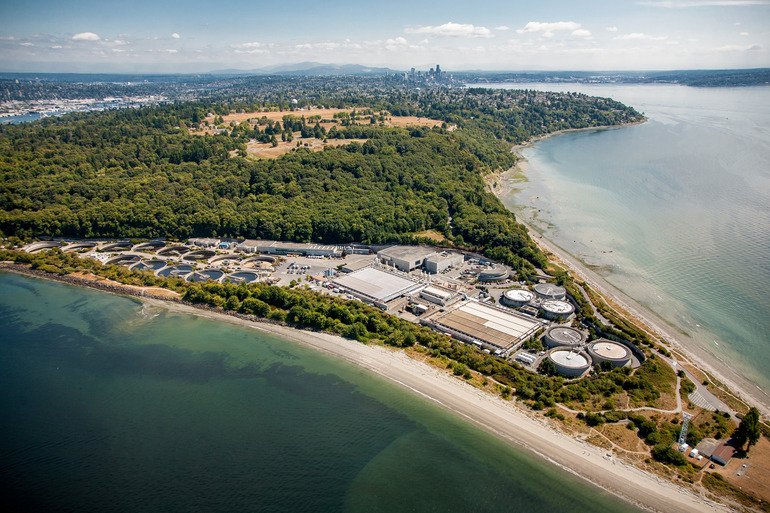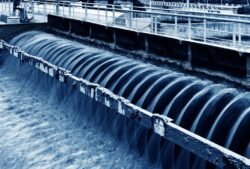West Point Wastewater Treatment Plant

West Point Wastewater Treatment Plant: A Tidal Wave of Innovation and Community Engagement
Nestled on the southwestern edge of Seattle, Washington, the West Point Wastewater Treatment Plant stands as a beacon of technological advancement and environmental stewardship. Operated by King County’s Wastewater Treatment Division, this plant is an essential part of the region’s infrastructure. It treats wastewater not only from Seattle but also from numerous surrounding communities, making it a linchpin in maintaining both public health and environmental quality.
Population Served and Wastewater Volume
The West Point Treatment Plant serves a vast and diverse population. Approximately 1.8 million residents rely on the plant for their wastewater needs. This includes a mix of urban, suburban, and even some rural communities. The plant processes an average of 90 million gallons of wastewater per day during dry weather. However, during heavy rainfall, this figure can surge dramatically, sometimes exceeding 440 million gallons per day, thanks to the combined sewer system in place.
The plant’s service area encompasses a wide range of communities, from high-density neighborhoods in Seattle to industrial zones and quiet suburban enclaves. This diversity poses unique challenges and requires tailored solutions to accommodate varying types and volumes of wastewater.
Treatment Capacity and Technological Innovation
West Point boasts an impressive treatment capacity. Designed to handle a peak flow of 440 million gallons per day, it is equipped with state-of-the-art technologies to manage the complex array of contaminants found in the wastewater it processes. The plant uses advanced primary and secondary treatment processes, including:
-
- Primary Treatment: Large solids and grit are removed through screening and sedimentation. This reduces the amount of organic matter that requires further treatment.
-
- Secondary Treatment: Biological processes are employed to further break down organic matter and nutrients. This stage includes aeration tanks where microorganisms consume organic pollutants, followed by sedimentation tanks to separate the biomass from treated water.
-
- Disinfection: Treated water is disinfected using chlorine and then dechlorinated before being discharged into Puget Sound. This step ensures that harmful pathogens are eliminated, protecting marine life and human health.
-
- Sludge Treatment: The byproducts of wastewater treatment, primarily sludge, undergo additional processing. Anaerobic digestion is used to stabilize sludge and reduce odors. The resulting biosolids are then recycled for beneficial uses such as soil amendment in agriculture and forestry.
Recent Local News and Key Projects
The West Point Treatment Plant has been in the spotlight recently for both its successes and challenges. A key topic of discussion has been the 2017 spill incident, during which a mechanical failure led to the discharge of untreated wastewater into Puget Sound. This event sparked a comprehensive review of the plant’s operations, leading to several upgrades and process improvements aimed at preventing future incidents.
Key Projects:
-
- Flood Mitigation and Resilience Improvements: Following the 2017 incident, significant investments have been made to enhance the plant’s resilience to extreme weather events. This includes upgrading the electrical systems and installing new backup power generators to ensure uninterrupted operation during power outages.
-
- Nutrient Reduction Initiatives: In response to increasing regulatory pressures to reduce nutrient pollution in Puget Sound, the plant has embarked on a project to upgrade its nutrient removal processes. Enhanced nitrogen and phosphorus removal techniques are being implemented to mitigate the impact of nutrient loading on the marine ecosystem.
-
- Energy Optimization: The plant is actively working towards reducing its carbon footprint. Recent projects have focused on energy recovery from biogas produced during the anaerobic digestion process. This biogas is captured and used to generate electricity, powering a significant portion of the plant’s operations and reducing reliance on external energy sources.
-
- Community Odor Control: Odor management continues to be a priority for the plant, given its proximity to residential areas. The installation of advanced odor control systems and careful monitoring ensures that emissions are minimized, maintaining good relations with the neighboring community.
Community Engagement
West Point Wastewater Treatment Plant has made community engagement a cornerstone of its operations. Transparency and public involvement are seen as essential to building trust and fostering collaboration with the residents it serves.
Educational Outreach and Tours:
The plant offers regular tours to schools, community groups, and the general public. These tours provide an inside look at the complex processes involved in wastewater treatment and highlight the plant’s role in protecting public health and the environment. Educational programs are tailored to different age groups, fostering environmental stewardship from an early age.
Public Forums and Stakeholder Meetings:
In the wake of the 2017 spill, West Point has ramped up its efforts to engage with the community through public forums and stakeholder meetings. These events serve as platforms for residents to voice their concerns, ask questions, and receive updates on ongoing projects and improvements. The plant’s leadership team is committed to addressing community concerns promptly and transparently.
Partnerships with Environmental Organizations:
West Point collaborates with various environmental organizations and research institutions to advance sustainable practices and innovate new treatment technologies. These partnerships have led to several pilot projects aimed at improving water quality and reducing the environmental impact of wastewater treatment operations.
Volunteer and Citizen Science Programs:
To further involve the community, the plant supports volunteer programs and citizen science initiatives. Residents are encouraged to participate in activities such as beach cleanups, water quality monitoring, and habitat restoration projects. These programs not only contribute to environmental conservation but also strengthen the connection between the community and the plant.
Future Outlook
As urbanization and climate change continue to pose new challenges, the West Point Wastewater Treatment Plant is poised to adapt and innovate. Future plans include:
-
- Enhanced Treatment Technologies: The integration of advanced treatment technologies, such as membrane bioreactors and advanced oxidation processes, to meet stricter regulatory standards and improve effluent quality.
-
- Climate Resilience: Ongoing efforts to adapt to climate change, including infrastructure upgrades to cope with rising sea levels and increased stormwater volumes.
-
- Community-Centered Design: Future projects will prioritize community input and aim to minimize any adverse impacts on nearby residents. This includes continued investments in odor control, noise reduction, and aesthetic improvements.
-
- Sustainable Practices: A commitment to sustainability will drive projects focused on resource recovery, zero waste initiatives, and carbon neutrality. The plant aims to set a benchmark for environmental performance in the wastewater treatment sector.
In conclusion, the West Point Wastewater Treatment Plant is more than just a facility; it is a dynamic entity that embodies the principles of environmental stewardship, technological innovation, and community engagement. By continually adapting to new challenges and prioritizing the needs and concerns of the community, West Point is helping to ensure a cleaner, healthier future for the Puget Sound region.

